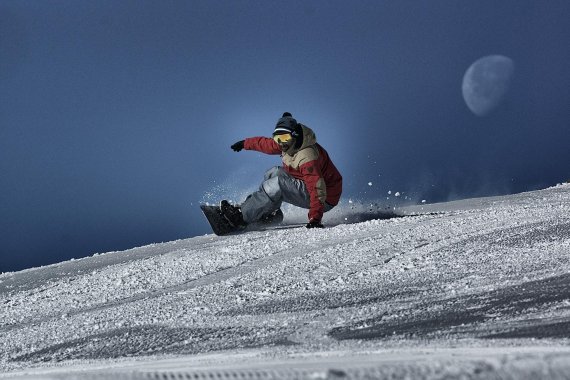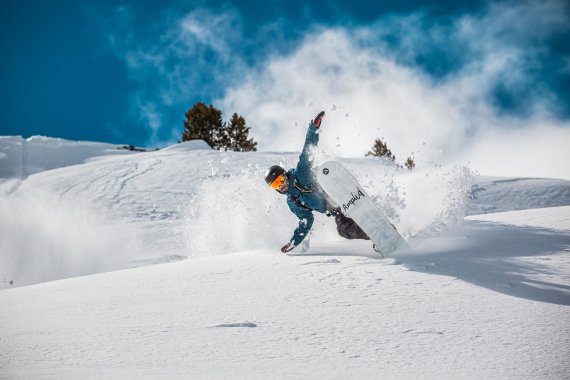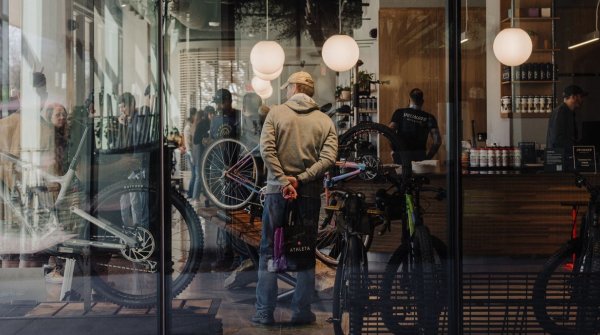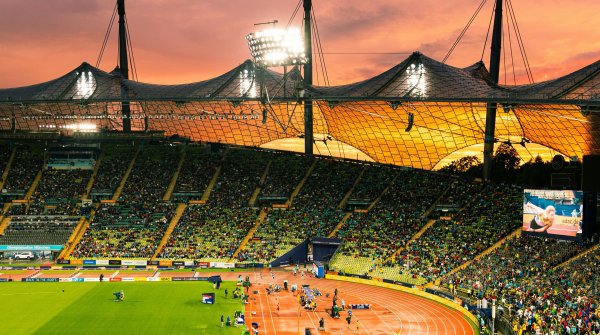
Nevertheless, there is reason for hope: A gripping Instagram video by Travis Rice and his friends Brian Iguchi, for example, can certainly be an initial spark for digital natives to throw themselves into the adventure of snowboarding. The conditions for this have never been better than they are today! I would like to explain why this is the case with the help of the following five snowboard trends.
Snowboarding has always stood for individuality. But after the competition formats that emerged in snowboarding, such as slopestyle, boardercross and big air, were copied and adapted bit by bit by ski associations, the unique selling point was missing here.
With the revival of the Banked Slalom, an original discipline of snowboarding, you stand out again clearly from other winter sports events. These fun events unite the snowboard family, because riders of all generations start here - from beginners to pro riders.
Many of these events are not just pure competitions, but rather a gathering of like-minded people celebrating snowboard culture. Barbecue sessions, concerts and parties in a family setting are a good breeding ground to revive the snowboard spirit.
Due to the steep trend towards "Higher, Faster, Further", snowboarding had lost its grip on the ground in recent years. What brands communicated in their commercials and video clips was hardly comprehensible for many non-snowboarders and potential new snowboarders.
With the revival of carving that focuses on the game of centrifugal force and the unique snowboarding feeling that comes with it, snowboarding is becoming approachable again. For the majority of active riders, snowboarding takes place on the ground and not in the air.
As positively and emotionally as this is now being communicated again by many snowboard brands, the chances are not bad that even anxious and skeptical parents will understand that snowboarding is not more dangerous than skiing, but is a hell of a lot of fun.
I know some first-generation snowboarders who swapped the board for two boards as they got older and sought a new challenge in ski touring. But since splitboarding is becoming more and more established as a popular segment in snowboarding, riders in the 40+ age group are also staying true to the board sport.
Splitboarding is also fully in line with the trend of the "active outdoor lifestyle", which is especially popular in this age group. And what's more: splitboarding offers the snowboard industry and retailers a wide range of cross-selling opportunities: from high-quality, technical clothing to a broad range of safety products. So in a market that is stagnant in itself, there are definitely opportunities for growth, albeit on a small scale.
There is no such thing as standing still in snowboarding. Thanks to the high density of creative minds in the development kitchens of the board forges, the spectrum of new shapes is continuously expanding.
The industry is not afraid to look back to the beginnings of snowboarding and is inspired by old shapes and related sports such as surfing when developing modern board designs.
In combination with the modern manufacturing processes and technologies, this creates many innovative boardshapes. Boards that are ideally suited for the most diverse forms of play of gliding in the snow and promote one thing above all: fun on the mountain
Whether handmade powsurfers from Äsmo, fishboards with good all-round properties from K2, Burton, Capita, Lib Tech, Ride and Nitro or balanced all-round shapes from Amplid, Rome, Korua, Salomon and Nidecker: Thanks to perfectly tuned boards, the conditions for learning snowboarding quickly and with a lot of fun have never been better.
In addition, there are innovative approaches for more comfort when entering the binding, such as the speed entry systems from Flow, SP, Völkl and K2, among others, as well as the newly developed Step-On binding from Burton. There is thus no longer any reason, even for comfortable or older winter sports enthusiasts, not to start snowboarding!

Producing winter sports products sustainably is a major challenge. It is encouraging to see how seriously and determinedly the snowboard industry is addressing the issue of sustainability.
Two examples: In November 2015, the U.S. brand Capita built the world's largest and arguably most modern snowboard factory in Feistritz an der Gail, Austria. The operation of the factory, which was christened the "Mothership"...
- ... is 100 percent CO2-neutral.
- All the electricity required for production is generated by the company's own hydroelectric power plant.
- The snowboards are also manufactured using water-based paints, vegetable resins and fewer solvents.
Capita MFG GmbH not only produces boards for its own label there, but also manufactures snowboards on behalf of many other well-known brands. A concept that the ski industry should definitely take inspiration from! After all, the ski industry has been happy to do so in the past when it comes to shapes, technologies or competition disciplines.
What applies to the hardware sector also applies to snowboard clothing. Here, the industry leader Burton takes a pioneering role and is on the verge of producing all textiles according to the strict bluesign standard. Furthermore, only feathers from 100 percent responsible poultry farming are used for the down jackets. Production according to these strict sustainability standards can be an inspiration for the entire industry.
Conclusion: Long live snowboarding!
Even though the sales figures and growth rates in the snowboard industry in recent years have given little reason to cheer, the above developments are a positive signal for me. They should encourage the entire industry to continue on its chosen path with the necessary foresight.
What goes for the hardware sector applies all the same for snowboard apparel. Here the industry top of the class Burton is taking on a pioneering role and is very close to producing all textiles according to the bluesign standard. Furthermore, down jackets will be exclusively use feathers from 100 percent responsible poultry farming. Production according to these strict sustainability standards can be an inspiration for the entire industry.
Conclusion: Long live snowboarding!
Even if sales figures and growth rates in the snowboarding industry gave little cause for jubilation in the past few years, the abovementioned developments are a positive signal to me. They should embolden the entire industry to continue to follow the struck path with the necessary foresight.
 Sports BusinessThe future of the bike industry: 6 innovative bike stores
Sports BusinessThe future of the bike industry: 6 innovative bike stores
- ISPO awards
- Mountain sports
- Bike
- Design
- Retail
- Fitness
- Health
- ISPO Job Market
- ISPO Munich
- ISPO Shanghai
- Running
- Brands
- Sustainability
- Olympia
- OutDoor
- Promotion
- Sports Business
- ISPO Textrends
- Triathlon
- Water sports
- Winter sports
- eSports
- SportsTech
- OutDoor by ISPO
- Heroes
- Transformation
- Sport Fashion
- Urban Culture
- Challenges of a CEO
- Trade fairs
- Sports
- Find the Balance
- Product reviews
- Newsletter Exclusive Area
- Magazine





